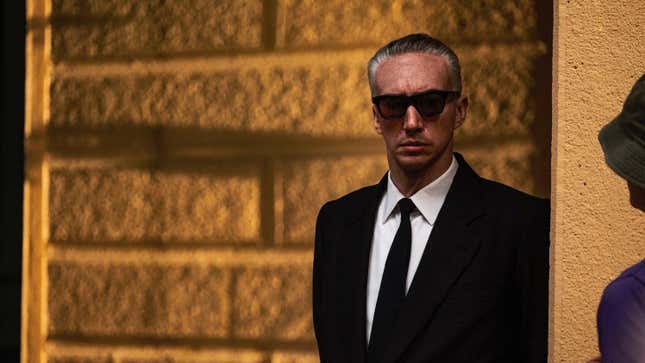
There’s a scene in Michael Mann’s Ferrari where beleaguered, self-obsessed car-manufacturer Enzo Ferrari (Adam Driver) is looking over race car designs alongside his son, Piero, whom he had with his mistress, Lina Lardi (Shailene Woodley), and has been raising in secret—from both the public and his wife, Penélope Cruz’s Laura Ferrari—for years. As Enzo gives his son a quick lesson on how engines work, Piero notes that, in addition to being fast, his father’s cars also tend to look nice. Enzo, perhaps loving the boy in this moment as much as he has ever loved anyone else, proudly notes that when a thing works better, “it’s usually more beautiful to the eye.”
Intentionally or not, Mann illustrates that philosophy at two key points in the film, specifically the only two moments where Ferrari’s cars are depicted not as loving expressions of engineering beauty but as unconvincingly rendered CG blobs: when they crash. Driver got some headlines earlier this year when he responded to a snotty question about the “cheesy” CG crashes with a pointed “fuck you, I don’t know,” but what the “cheesy” questioner missed is the fact that the crashes actually put you into Enzo Ferrari’s headspace perhaps better than anything else in the film.
The first crash occurs early on, when Formula 1 driver Eugenio Castellotti is testing a new Ferrari car for the upcoming season. With his team in a slump, Ferrari is desperate to prove that this car can keep up with his rivals at Maserati, so he pushes Castellotti to go faster and faster until the driver hits a curb and rolls the car. Castellotti is immediately killed and thrown from the car, with his body tumbling like a ragdoll. It’s shocking, and the visual of Castellotti flipping through the air is so jarringly different from every other visual in the movie until that point that there’s a good chance it will pull even the most committed viewer out of the film.
But Driver’s Ferarri seems almost completely unfazed. A man just died in front of him, driving his car, following his instructions to go faster, but all Ferrari sees is that the test failed. Therefore—for both Ferrari and the audience, albeit in different ways—the car is no longer “beautiful to the eye.” Like, it literally looks bad when the car fails, putting you in Ferrari’s head and tricking you into seeing the tragedy as little more than a technical failure. A person is dead, sure, but the car failed and the CG was ugly.
The second crash comes at the climactic moment of the film, and the aftermath is an even more literal illustration of Ferrari’s feelings about the balance between human life and technical achievement. During the harrowing Mille Miglia race in 1957 (a 1,000-mile journey across public roads in Italy), which Ferrari believes he must win in order to prove how good his cars are and to try and save his company, driver Alfonso de Portago loses control of his Ferrari 335 S and crashes into a crowd. De Portago, his navigator, and 10 spectators are killed.
The crash itself is another off-putting CG showcase, with the car bouncing across the road like something out of a video game, but Mann holds the camera on the crowd as the car collides with the spectators and the results are truly horrifying. Human lives—real human lives, since this was a real thing that happened—are tossed aside so casually that it feels almost like an indictment of everyone who might’ve criticized the earlier crash or who might’ve rolled their eyes when the second one happened. And, just to make sure that nobody walks away thinking “that was a cool car crash,” Mann cuts back to the crowd later, lingering on bodies that have been ripped apart by the carnage.
And how does Ferrari react? By dismantling the remains of the car, piece by piece, until he can confirm whether or not it was a problem with his car that caused the crash. The technical failure is all he cares about, but perhaps viewers—having seen the human cost rendered in surprisingly chilling detail—can now see that he’s wrong. The movie even ends somewhat triumphantly for Ferrari, with an investigation determining that the crash wasn’t caused by anything that was his (or his car’s) fault. He’s vindicated, he gets to save his company, and he no longer has to lie to his wife about how much he loves his secret family. Hell, one of his other cars even managed to win the Mille Miglia, so Enzo Ferrari gets everything he wanted. Lives were ruined, yes, but that’s second to the horror of his car not working right and the thing he dedicated his life to turning out to be a failure.
Driver doesn’t really emote a lot as Ferrari. It’s rare that you get a sense of what he’s thinking behind his big sunglasses, beyond his scheming to save his company or his verbal sparring with his wife. But when you see a CG model of a car flipping through the air, you likely won’t think “oh, there’s a man in there who is going to die.” Like Enzo Ferrari, you’ll think something along the lines of, “something has gone technically wrong here, and I don’t like it.” It’s not really a nice headspace to be in, assuming you care about people being hurt, but the movie makes you sit in it right up until the moment it becomes unbearable.